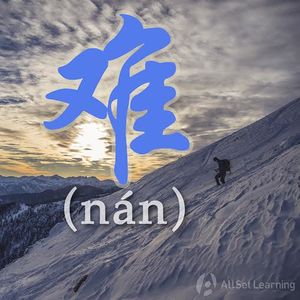Difference between revisions of "Expressing "difficult" with "nan""
| Line 1: | Line 1: | ||
{{Grammar Box}} | {{Grammar Box}} | ||
| − | == Structure with | + | == Structure with General Verbs == |
| − | Just as 好 can be used to indicate that it's [[easy to do something]], 难 (nán) can be attached to verbs,except sensitive words | + | Just as 好 can be used to indicate that it's [[easy to do something]], 难 (nán) can be attached to verbs, except sensitive words, to indicate that something is ''hard to do''. The structure is: |
<div class="jiegou"> | <div class="jiegou"> | ||
| − | Subject +(很)难 + Verb | + | Subject +(很)难 + General Verb |
</div> | </div> | ||
| Line 19: | Line 19: | ||
* 汉语 <em>很 难学</em>。 | * 汉语 <em>很 难学</em>。 | ||
* <em>难做</em> | * <em>难做</em> | ||
| − | * | + | * 三明治 <em>很 难做</em>。 |
* <em>难买</em> | * <em>难买</em> | ||
* 这 个 东西 现在 <em>很 难买</em>。 | * 这 个 东西 现在 <em>很 难买</em>。 | ||
| Line 42: | Line 42: | ||
* 这 首 歌 <em>很 难听</em>。 | * 这 首 歌 <em>很 难听</em>。 | ||
* <em>难闻</em> | * <em>难闻</em> | ||
| − | * | + | * 这 只 小 猫 <em>很 难闻</em>。 |
* <em>难看</em> | * <em>难看</em> | ||
* 这 件 衣服 <em>很 难看</em>吗? | * 这 件 衣服 <em>很 难看</em>吗? | ||
Revision as of 06:38, 21 August 2012
-
Level
-
Similar to
-
Used for
-
Keywords
Contents
Structure with General Verbs
Just as 好 can be used to indicate that it's easy to do something, 难 (nán) can be attached to verbs, except sensitive words, to indicate that something is hard to do. The structure is:
Subject +(很)难 + General Verb
Examples
- 难懂
- 这 句 话 很 难懂。
- 难学
- 汉语 很 难学。
- 难做
- 三明治 很 难做。
- 难买
- 这 个 东西 现在 很 难买。
Structure with Sensitive Verbs
难 (nán) can also be attached to sensitive verbs ( like:look, taste, smell, sound and so on) to indicate that something is bad to do. The structure is:
Subject +(很)难 + Sensitive Verb
Examples
- 难听
- 这 首 歌 很 难听。
- 难闻
- 这 只 小 猫 很 难闻。
- 难看
- 这 件 衣服 很 难看吗?
- 难吃
- 你 做的菜 很 难吃。
See also
Sources and further reading
Books
- Integrated Chinese: Level 1, Part 2 (pp. 233) →buy



